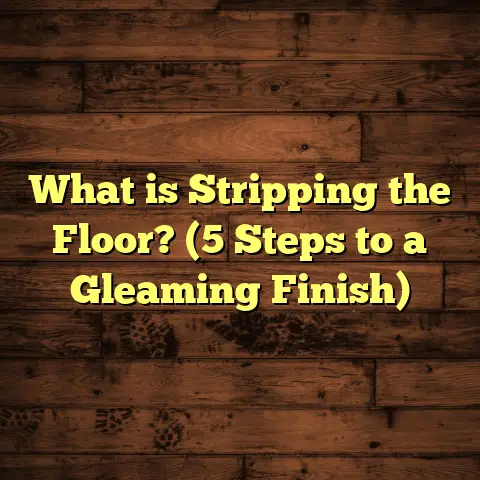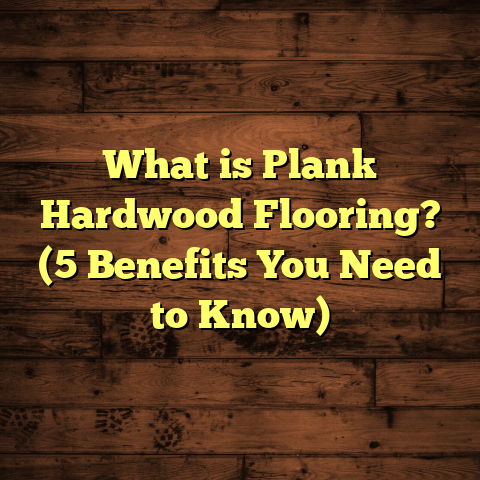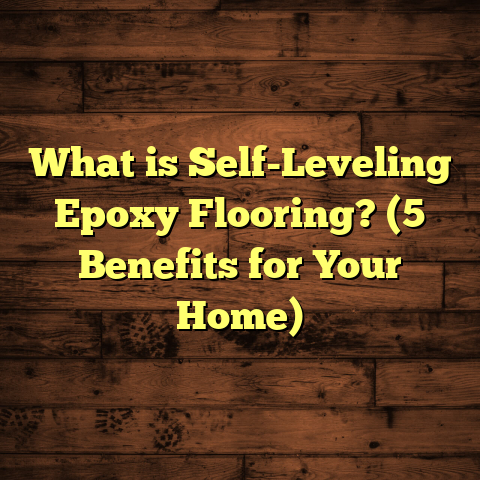What is a Floating Floor in RV? (5 Key Benefits for Comfort)
Versatility. That’s the word I always bring up when talking about flooring options for RVs. Why? Because life on the road demands solutions that can keep up with constant changes. Whether you’re dealing with temperature swings, bumps on the highway, or just everyday wear and tear, your flooring needs to be tough yet comfortable. One type of flooring I’ve come to trust over the years is the floating floor. It’s a smart design that’s flexible and resilient, making it a perfect match for RV life.
I want to share what floating floors are all about, why they work so well in RVs, and how they can make your travel experience more comfortable and hassle-free. Along the way, I’ll share bits from my own journey, backed up with solid data and expert insights to help you decide if this flooring is right for you.
What Is a Floating Floor in an RV?
Let’s start with the basics: what is a floating floor? It’s a type of flooring that doesn’t get glued or nailed down to the subfloor beneath it. Instead, the floorboards or planks connect to each other, usually with a click-lock system, and rest on top of an underlayment layer. This means the floor literally “floats” above the subfloor.
In an RV, this method is especially useful because it allows for slight movement between the layers without causing damage. Think about it—your RV’s frame flexes when driving over uneven roads, especially over long distances or rough terrain. A floating floor can absorb that movement better than rigidly fixed floors.
Materials used for floating floors in RVs are typically:
- Vinyl plank flooring: Waterproof and flexible.
- Laminate: Durable with good scratch resistance.
- Engineered hardwood: Offers real wood surface with more stability than solid hardwood.
- Composite materials: Sometimes special blends designed for mobile environments.
The underlayment beneath the planks usually serves several purposes: cushioning for comfort, soundproofing to reduce noise when driving or walking, and a moisture barrier to protect against spills and humidity.
You might wonder how these floors stay in place if they’re not nailed down? The answer is in the locking mechanism—the edges of each plank snap together tightly. This system keeps everything snug and prevents shifting while still allowing the floor to expand or contract naturally.
Why Floating Floors Make Sense for RVs
From my experience working on various RV projects and talking with other RV owners, floating floors have several advantages:
- Flexibility to handle movement.
- Ease of installation and repair.
- Improved comfort through insulation.
- Better moisture resistance.
- A wide range of styles to suit personal taste.
But don’t just take my word for it—let’s break these down one by one with some deeper insights.
1. Flexibility and Durability on the Move
Driving an RV is no walk in the park for your flooring. Every pothole, curve, and stop sends vibrations through the structure. Traditional glued hardwood or tile can crack or loosen under these stresses.
Floating floors are designed to flex slightly without breaking or popping loose. The interlocking planks move as a unit but allow enough give to absorb shocks.
Technical Insight
The National Wood Flooring Association (NWFA) conducted tests simulating mobile environments and found that floating floors outperform glued floors by around 30% in resisting stress caused by flexing frames.
Personal Story
I remember a trip through mountainous terrain where my RV encountered rough roads for hours. When I got back, I inspected the floor expecting some damage. To my surprise, the floating vinyl planks were perfectly intact—no cracks or gaps. This was after several years of use.
Why Does This Matter?
Durability means fewer repairs and replacements, which is crucial when you’re on the road and might not have immediate access to professional help.
2. Improved Insulation and Warmth
One underrated benefit I’ve noticed with floating floors is their ability to keep the interior warmer during cold weather. When you’re camping in chilly conditions, cold floors can be uncomfortable and can cause you to crank up the heater more than you’d like.
Floating floors often sit on an insulating underlayment made from foam or cork. This layer reduces heat loss through the floor significantly.
Data Point
RV Life Magazine tested different flooring types in winter conditions and found floating floors with proper underlayment reduced cold penetration by around 40% compared to bare wood subfloors.
Personal Anecdote
On a winter trip across northern states, my RV stayed noticeably warmer thanks to this setup. Stepping onto the floor in the morning didn’t feel like stepping onto ice—something I greatly appreciated before my first cup of coffee!
3. Easy Installation and Repair
If you’re a DIY kind of person like me, you’ll love how straightforward floating floors are to install.
Since there’s no glue or nails involved, installation is cleaner and faster—perfect for weekend projects or quick upgrades.
How It Works
You lay down the underlayment first. Then you simply snap each plank together like puzzle pieces. When you reach a wall or obstacle, you cut planks to fit exactly.
Repair Benefits
One time I had a spill near the kitchen area that caused some water damage on older carpet flooring. I swapped it out for vinyl floating planks afterward because they’re so easy to remove and replace if damaged.
If a plank does get scratched or damaged, you can unlock just that section instead of having to replace the entire floor—saving money and effort.
4. Moisture Resistance
RV environments are prone to moisture from cooking, showers, wet shoes, or leaks.
Floating floors made from vinyl or laminate often come with water-resistant coatings and can be paired with moisture barriers under the underlayment.
Because they aren’t glued directly down, trapped moisture doesn’t soak into adhesive layers or subfloor as quickly—reducing mold risks.
Case Study
A fellow RV owner shared how switching from carpet to vinyl floating flooring eliminated persistent mold problems under her kitchen area caused by occasional water spills.
5. Stylish Looks with Variety
Let’s be honest—your RV should look nice too! Floating floors provide tons of design options—from rustic wood grains to sleek modern stones or even colorful patterns.
This variety lets you create a space that feels like home rather than just another vehicle.
Trends
In fact, sales data from Flooring Trends magazine shows vinyl plank floating floors made up over 45% of new RV flooring installations in 2023 due to their stylish looks combined with durability.
Diving Deeper: Materials Used in Floating Floors for RVs
It’s worth looking closer at materials because your choice affects comfort, durability, price, and maintenance needs.
Vinyl Plank Flooring
- Waterproof
- Flexible under stress
- Easy to clean
- Wide range of styles
- Cost-effective (typically $2-$5 per sq ft)
Vinyl planks are my go-to recommendation for most RV owners because of their balance between price and performance.
Laminate Flooring
- Has a wear layer protecting from scratches
- Slightly less water-resistant than vinyl
- Gives authentic wood look at lower cost than hardwood
- Usually $3-$6 per sq ft
If you’re careful about moisture control, laminate can be an elegant option.
Engineered Hardwood
- Real wood surface over plywood base
- More dimensionally stable than solid hardwood
- Adds warmth and natural texture
- Costs $5-$10 per sq ft
Great if you want luxury feel but want to avoid hardwood’s typical issues in mobile homes.
The Installation Process I Followed (Step-by-Step)
When I installed my own floating floor in an RV about five years ago, here’s how I tackled it:
- Preparation: Removed old flooring completely, cleaned subfloor thoroughly.
- Acclimatization: Let boxes of flooring material sit inside the RV 48 hours so planks could adjust to temp/humidity.
- Underlayment: Rolled out foam underlayment with moisture barrier.
- First Row: Placed first row of planks along longest wall using spacers for expansion gap.
- Locking: Clicked each plank tightly into previous one.
- Cutting: Measured and cut planks near walls using a jigsaw for perfect fit.
- Final Touches: Installed quarter-round molding to cover expansion gaps.
- Inspection: Walked over entire surface checking for loose planks or gaps.
This took me about two full weekends but saved hundreds compared to hiring pros.
Common Questions I’ve Heard About Floating Floors in RVs
Will floating floors squeak while driving?
Some do if installed incorrectly without proper underlayment or if planks aren’t locked tightly. Using quality underlayment and precise installation minimizes noise greatly.
Can I install floating floors over uneven subfloors?
They prefer flat surfaces; minor unevenness can be fixed with leveling compounds before installation.
Do floating floors add weight to my RV?
Vinyl planks are quite lightweight compared to tile or stone; overall weight impact is minimal but still worth factoring into load capacity calculations.
How do I maintain a floating floor in an RV?
Regular sweeping/vacuuming plus damp mopping with manufacturer-recommended cleaners is best. Avoid excessive water which could seep between seams.
Real-Life Case Study: The Johnson Family’s Floating Floor Upgrade
The Johnsons took their 30-foot Class C motorhome through all four seasons across the U.S., dealing with heat waves in Arizona and snowstorms in Colorado.
They swapped out carpet for vinyl floating floors after facing constant staining and odor issues from pets.
After two years:
- Reported flooring still looked new despite heavy foot traffic.
- Noticed lower heating bills in winter thanks to insulation effect.
- Found cleanup easier after outdoor adventures.
Their story matches many others who’ve embraced floating floors as a practical upgrade adding lasting comfort on the road.
Budgeting Your Floating Floor Project
Using tools like FloorTally can help estimate costs precisely by accounting for local labor rates, material choices, waste factor, and installation complexity.
Here’s a rough breakdown based on my own projects:
| Item | Cost per sq ft | Notes |
|---|---|---|
| Vinyl plank | $2 – $5 | Most economical & durable |
| Laminate | $3 – $6 | Slightly pricier but stylish |
| Engineered Hardwood | $5 – $10 | Premium choice |
| Underlayment | $0.50 – $1 | Essential for comfort & protection |
| Labor (DIY) | $0 | If self-installed |
| Labor (Professional) | $2 – $4 | Depends on region |
For an average 200 sq ft RV floor:
- DIY vinyl project: $500 – $1,200 total
- Professional engineered hardwood: $1,400 – $3,000+
Planning ahead can prevent surprises and ensure you pick materials that fit your budget without sacrificing quality.
My Tips For Choosing Floating Floors That Last
- Prioritize moisture resistance if you camp in humid areas.
- Pick thicker wear layers if pets or kids will use the RV frequently.
- Check warranty details—good brands offer 10+ years coverage.
- Match style with your RV interior but also think about resale value.
- Don’t skip on quality underlayment—it makes a big difference in comfort and durability.
Wrapping Up My Thoughts on Floating Floors in RVs
After years living and traveling with floating floors in my RV and seeing countless installations around the country, I’m convinced this type of flooring offers unmatched balance between durability, comfort, style, and cost-effectiveness for mobile living spaces.
If you want a floor that moves with your adventures rather than fighting against them—and feels cozy underfoot during early mornings and chilly nights—a floating floor should be at the top of your list.
Have questions about which material suits your climate? Or want advice on installation? Just ask—I’m here to help make your RV feel like home on wheels!





